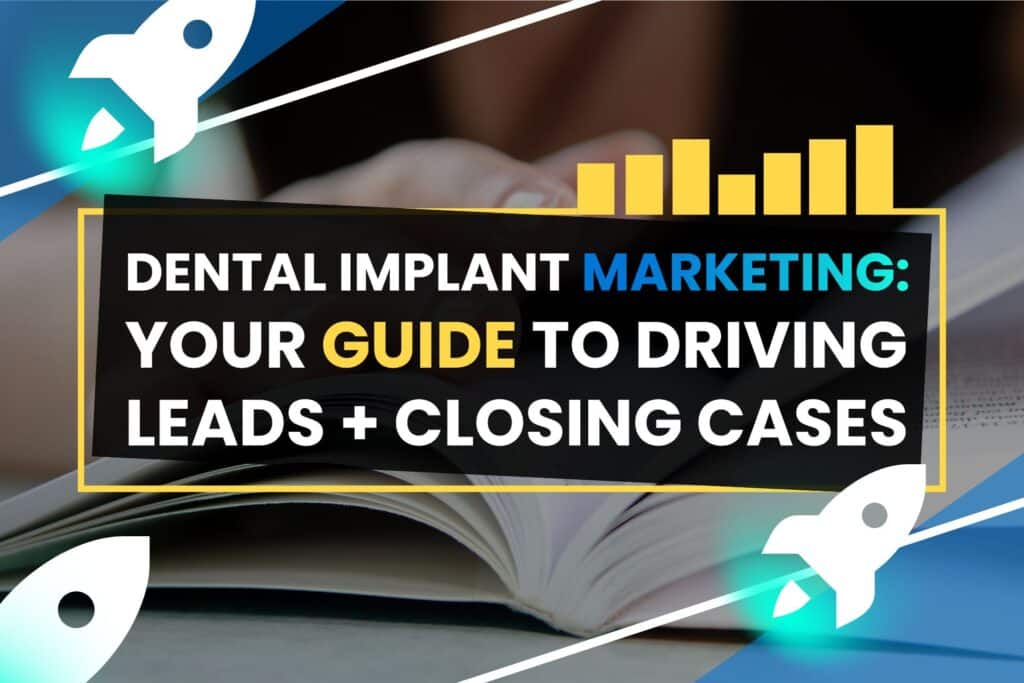Roughly 10,000 baby boomers reach retirement age every day. Many of them could improve their quality of life with full-arch dental implants (or single-tooth!). And they have the resources to afford treatment.
This is a massive opportunity for dentists. Unfortunately, too many practices — even those that specialize in full-arch treatment — don’t know how to stand out in a crowded market and bring more potential patients through their doors.
That’s why we wrote this short guide to help you do implant marketing right. Read it to learn the tactics my team and I use to generate implant leads for dentists across the country — and how to turn those leads into new patient starts.
Why you need a dental implant marketing plan
Dental implants are a big business.
In the United States alone, the market for implants is exploding. Dentists are expected to earn almost $2 billion from implant sales this year alone — and that number will grow by over 10 percent a year through 2030.
But with so much cash on the line, the market has also become increasingly crowded. Regular dentists looking to add or grow an implant patient base find themselves competing for patients not just with each other, but with specialized dental implant centers — many of which either build serious in-house marketing teams or partner with major agencies.
Now, I think there are enough implant patients to go around (10,000 new retirees each day, remember!). But you’re not going to be able to break into the market using a business-as-usual approach.
To create predictable, lasting implant patient growth, you need to take your traditional dental marketing strategy and throw it out the window.
👉 To get the complete, step-by-step playbook to building a killer implant marketing funnel and learn in person from top implant marketing leaders, join us for our next Full Arch Advantage live event.
What makes implant marketing so different from regular dental marketing?
The key difference between marketing for general dental treatments and implants boils down to what marketers like me call the buying cycle.
Patients looking to treat tooth pain, get a cleaning or fix a broken crown operate on a short buying cycle. They Google “dentist near me,” read reviews for local practices, and will typically schedule an appointment within a few days of beginning their search.
Implant patients… don’t do that. They make decisions on a long buying cycle, often spending months or even years researching treatments, speaking with different dentists, and weighing their options.
And this makes a ton of sense! Implants cost exponentially more than basic dental care, so we can hardly be surprised that patients want to put some serious thought into choosing when and if to begin treatment.
But it also means that if you try marketing to implant patients like you do regular patients, you’re going to fail. To succeed, your marketing has to fit the implant buying cycle — which requires patience and follow-through.
Implant marketing tactics that work (and mistakes to avoid)
The outline of an effective overall implant growth strategy is simple:
- Create new implant leads.
- Nurture those leads over time.
- Turn them into patients once they’re ready for treatment.
But of course, the devil’s in the details. Here’s how you start building an implant marketing funnel that accomplishes your goals to deliver long-term growth.
Outline a basic buyer’s journey
The buyer’s journey is a way of thinking about the process of a lead becoming a patient from the perspective of a potential patient. Creating one will help you understand the different steps that go into making a decision to seek out and accept treatment.
A basic buyer’s journey has three stages:
- Awareness
- Consideration
- Decision
In the awareness stage, a potential patient recognizes that they have a problem with their teeth and becomes, well, aware that dental implants could present a solution. In the consideration stage, they are doing research into treatment options. And in the decision stage, they are deciding which doctor to go with and solving additional issues like financing.
Creating a buyer’s journey for your patients will allow you to target your marketing to patients in each stage of this process. You might use Facebook ads to connect with patients in the awareness stage (more on this in a moment), Google ads for patients in the consideration stage, and a combination of email marketing, 1:1 lead nurturing, and in-person consults for those who are getting closer to making a decision.
Gain insight by funnel hacking top implant practices
If you want to see how your top competitors approach marketing, try funnel hacking. This means scoping out their marketing from the perspective of a potential patient to see what they’re doing and why it works.
Google them, click through their ads, take a look at their websites, and sign up for their email lists. You’ll start to see how their funnels work — an ad leads to an offer for a free consult leads to a drip email campaign until you follow through.
Whether you’re new to implant marketing or know your way around, doing this can deliver valuable, actionable insights that can benefit your own practice. You’ll also be able to avoid some of the headaches that come from trying to reinvent the wheel on your own by simply borrowing what already works.
Focus on paid ads over SEO to generate leads
While you might be tempted to invest in SEO to generate leads, we’ve found that you’ll be better off focusing on PPC campaigns.
Why? SEO can take a year or more to begin producing a significant volume of leads. And it’s also subject to the ever-changing whims of Google’s search algorithm, which means that you can spend months trying to rank for top keywords — only to lose that ranking overnight.
By contrast, paid ads will start creating leads much more quickly — often within a matter of weeks. Try a combination of Facebook and Google ads — the former to reach potential patients who may not even be thinking about implants as an option (awareness stage) and the latter to connect with higher-intent patients who are already searching for implant dentists (consideration stage).
(Your ads should funnel leads to provide their contact information and request a consult and additional information.)
PPC is also significantly more scalable. Once you find a formula that works, you can typically achieve predictable growth as you increase your budget (meaning that if you need to spend $1,500 to generate 10 leads, you can feel confident that investing $3,000 will get you 20 leads).
We’re not anti-SEO at all (in fact, our team optimizes all of our sites for SEO). But for an implant dentist looking to see serious growth, PPC is definitely the way to go.
Separate serious patients from window shoppers using video ads
Implant marketing is expensive. You can expect to spend roughly 10X as much money to generate a full-arch patient as you would bringing in a new hygiene patient, for example.
Part of the reason why is that so many people are window shopping for implants. They might be curious, but they’re years away from being ready to buy.
Unfortunately, this means you can very easily invest hundreds of dollars (if not more) in marketing to someone who is never going to become a patient.
One way to avoid this is to run video ads. If you make an ad that’s say, three minutes long, you can safely assume that only someone who is actively pursuing treatment will watch all or most of it. (Nobody has the attention span anymore to do that if they’re not serious.)
If somebody does watch 75-ish percent of your video ad, you can then retarget additional ads to reach them or put more resources towards marketing to them.
Get new leads on the phone ASAP
Once you have a lead’s contact information, make a real effort to get them on the phone right away. When you do, explore where they are in their buyer’s journey, and if you can, get them on the books for an initial consult.
If you don’t succeed at making phone contact or the person isn’t ready to come in for a consult, then you can continue to follow up or put them into an email marketing campaign.
Either way, it’s important to move quickly here. When a lead fills out your contact form, they’re excited — genuinely interested in learning more about treatment.
However, that excitement can drop dramatically over time, so you want to encourage them to take the next step while the iron is still hot.
Use your CRM to build relationships over time
Now, as we’ve already touched on above, implant marketing is a marathon, not a sprint. Even if you manage to schedule a new lead for a consult right away, it’s highly unlikely that they’ll be ready to start treatment.
This means you’ll need to do some serious lead nurturing. A good lead nurturing effort may last for anywhere from three months to a year and will cost time and money — but will also generate an ROI that makes it all worth it.
One essential tool here is your CRM (customer relationship management) software. You simply can’t do effective lead nurturing without using one — and unless you’re marketing to only a tiny handful of leads, just using a spreadsheet is not going to cut it.
A good CRM allows you to track every lead you have in your sales pipeline (and as much as some dentists hate the word sales, that’s exactly what the implant game is all about), identify where they are in the buyer’s journey, and allow you to build long-term relationships that will ultimately increase your starts while lowering your cost per start.
Once you have a CRM set up, you can use it to:
- Set up ongoing 1:1 lead nurturing phone calls.
- Run drip email marketing campaigns.
You can also track individual questions, blockers, and other issues that come up during the lead nurturing process for each lead.
Nurture leads with regular 1:1 check-in calls
If a potential patient has expressed interest in treatmnt or come in for an initial consult but doesn’t commit to starting, you’ll want to regularly do lead nurturing with that person over the phone. Your goal is to continue creating rapport, help them overcome barriers to starting, and build excitement.
Here, ideally, you have someone on your team to serve as a designated implant lead coordinator. Follow-up calls typically take as many as 10-12 hours a week (this number will vary depending on the size of your practice and volume of incoming leads), so it helps to make doing them a specific part of someone’s job.
Understand that you may need to do lead nurturing calls for up to 12 months in order to turn a lead into a start. This is a big part of why implant marketing is so expensive — you’re talking about investing significant hours into each individual person in your pipeline, with no guarantee you’re going to close the case.
However, in our experience, if you skip this step, you’ll end up costing yourself more than you’ll save and lose case after case to the practices that are committed to following through.
Create helpful, compelling web and email content
I’ve already said SEO should not be your primary strategy for generating leads. That doesn’t mean you don’t need great content for your website and email marketing.
At a minimum, you should make sure that your website is optimized to clearly promote your services and drive your ad traffic to provide their contact information. You’ll also want to build a landing page for your site that clearly lays out the benefits that dental implants can provide (this is probably where you’ll send your ad traffic).
You can talk about the implant process, but you’ll want to focus on helping people to understand how All-on-4s, for example, can give them a new smile and a fresh lease on life. Before and after photos can be great here.
We’ve mentioned this a few times above, but you’ll also want to create an email marketing series that addresses different benefits, FAQs, practical issues around financing, and anything else a lead might need to know in order to make an informed decision.
All these areas also make great topics for individual blog posts, which you can then link to in email campaigns or refer leads to during nurturing calls.
Lead with value in your consults
When a potential patient does come in for a consult, too many doctors make a huge mistake: they try to impress the patient. Specifically, they spend most of the consult getting into the nitty-gritty details of the implant process as a way of trying to communicate that they know what they’re doing.
But most people don’t care about that stuff — or at least it isn’t top of mind. And so they leave feeling a disconnect with the doctor or treatment coordinator and are less likely to follow up.
What do they care about? How implants are going to improve their lives.
That’s why you need to lead with value in all your consults — to help potential patients understand how implants offer the transformation they seek. No one should leave your office after a consult without a clear sense of how working with you could help them experience a higher quality of life, look and feel better, smile with confidence… you get the idea.
Equally important is taking the time to listen to a patient’s fears, concerns, and whatever struggles they’ve experienced that have led them to you. This is more of the rapport building we’ve already mentioned several times before, and it’s absolutely essential to creating trust.
Do those two things and you’ll be putting yourself in a position to succeed.
👉 For more proven, tactical insights you can use to create implant patients, check out the Full Arch Advantage podcast series.
Make this simpler by partnering with an agency
Finally, consider whether it makes more sense to partner with a dental marketing agency that already knows how to do all of this stuff (like us). Rather than building up your in-house marketing operation, a great marketing partner will tackle all of it for you — typically without the hiccups and learning curve you’ll have to face doing it on your own.
However, as we’ve shown you above, implant marketing is complicated. This means not all agencies — even those with experience creating patients for general dentists — will be up to the challenge.
Look for an agency that has:
- Significant experience specifically working with implant practices.
- A clear strategy for generating leads at scale.
- Focuses on hitting your specific, measurable goals.
- Understands how an implant practice functions.
- Doesn’t just create leads, but helps you convert them into starts.
- Tracks your entire marketing funnel so you’ll always know your results and ROI.
Obviously, this is how we work here at SMC.






